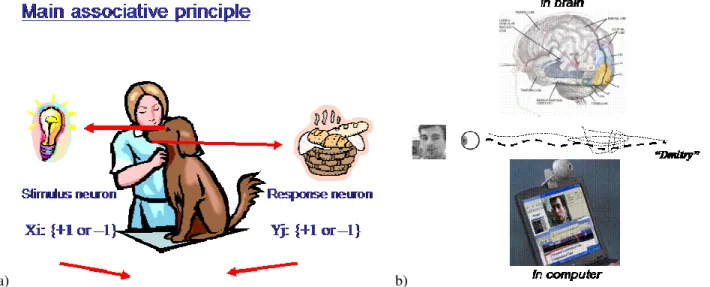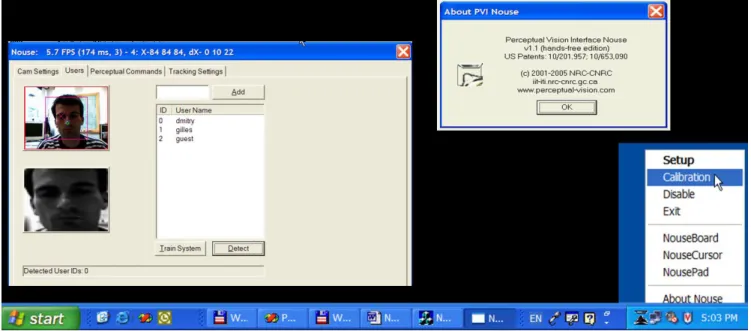Publisher’s version / Version de l'éditeur:
Vous avez des questions? Nous pouvons vous aider. Pour communiquer directement avec un auteur, consultez la première page de la revue dans laquelle son article a été publié afin de trouver ses coordonnées. Si vous n’arrivez pas à les repérer, communiquez avec nous à PublicationsArchive-ArchivesPublications@nrc-cnrc.gc.ca. Questions? Contact the NRC Publications Archive team at
PublicationsArchive-ArchivesPublications@nrc-cnrc.gc.ca. If you wish to email the authors directly, please see the first page of the publication for their contact information.
https://publications-cnrc.canada.ca/fra/droits
L’accès à ce site Web et l’utilisation de son contenu sont assujettis aux conditions présentées dans le site LISEZ CES CONDITIONS ATTENTIVEMENT AVANT D’UTILISER CE SITE WEB.
Second Canadian Conference on Computer and Robot Vision Workshopon Face Processing in Video (FPIV'05) [Proceedings], 2005
READ THESE TERMS AND CONDITIONS CAREFULLY BEFORE USING THIS WEBSITE.
https://nrc-publications.canada.ca/eng/copyright
NRC Publications Archive Record / Notice des Archives des publications du CNRC : https://nrc-publications.canada.ca/eng/view/object/?id=873fecd2-d358-4306-a8fe-352d1de51c4e https://publications-cnrc.canada.ca/fra/voir/objet/?id=873fecd2-d358-4306-a8fe-352d1de51c4e
NRC Publications Archive
Archives des publications du CNRC
This publication could be one of several versions: author’s original, accepted manuscript or the publisher’s version. / La version de cette publication peut être l’une des suivantes : la version prépublication de l’auteur, la version acceptée du manuscrit ou la version de l’éditeur.
Access and use of this website and the material on it are subject to the Terms and Conditions set forth at Towards Building User Seeing Computers
National Research Council Canada Institute for Information Technology Conseil national de recherches Canada Institut de technologie de l'information
Towards Building User Seeing Computers *
Bessens, G., and Gorodnichy, D. May 2005
* published at Second Canadian Conference on Computer and Robot Vision Workshop on Face Processing in Video (FPIV'05). May 9-11, 2005. Victoria, British Columbia, Canada. NRC 48210.
Copyright 2005 by
National Research Council of Canada
Permission is granted to quote short excerpts and to reproduce figures and tables from this report, provided that the source of such material is fully acknowledged.
Towards building user seeing computers*
∗
Presented at the Second Workshop on Face Processing in Video (FPiV’05) held jointly with AI/GI/CRV'05, 9-11 May 2005, Victoria, BC, Canada, 2005.
Gilles Bessens and Dmitry O. Gorodnichy Institute for Information Technology (IIT-ITI) National Research Council of Canada (NRC-CNRC)
Montreal Rd, M-50, Ottawa, Canada K1A 0R6 http://iit-iti.nrc-cnrc.gc.ca
Abstract
Of all human senses, vision is the primary source of information about the outside world. When hu-mans lose a sense of touch or a sense of hearing, they can still communicate with each other using vi-sion. The same is for computers. When information cannot be entered into computer using hands or speech, vision could provide a solution, if only computers can see. Based on our recent work on design-ing a vision-based software to enable people with disabilities to work with a computer, we summarize the main problems related to the task and indicate the directions for the design of computers which can see with a specific task in hand of seeing a computer user.
1. Seeing tasks
When humans lose a sense of touch or hearing, they can still communicate using vision. The same is for computers: When information cannot be entered into a computer using hands or speech, vision could provide a solution. Therefore it is important to develop computers which can see.
Figure 1: Seeing a user involves three tasks.
Below we define the three primary tasks involved in seeing a user (see Figure 1):
1) "Where" task - to see where is a user, i.e. to know the position of the user's face (or facial fea-ture) in 3D. This, in general case, is represented as a tuple of six numbers: {x,y,z,α,β,γ}, of which often only two can be extracted and/or used.
2) "What" task - to see what is a user doing, e.g. opening the mouth, the eyes, lifting eye-brows, turning or nodding the head etc.
3) "Who" task - to see who is the user, which would usually imply associating a nametag to the face observed.
The first of these tasks has been already widely approached by computer vision researchers, and as a result a number of face tracking technologies have been recently developed. The main goal is therefore seen in developing a framework to combine these techniques with those to be developed for the other two tasks, and to tailor the entire thus built vision-based user perception systems for the users' needs.
2. Main results
Figure 2 shows typical results of detecting a user’s face position with web-cameras using three video modalities: motion, colour and intensities (See also Table 1 which summarizes milestone results related to all three computer seeing tasks). These results show that now it is possible to quite reliably to detect an approximate position of a user’s face.
a) b)
Figure 2: Typical “where” task results achieved without convex-shape nose tracking: a) computer-user setup showing six different web-cameras, b) face detection results obtained using these cameras.
The invention on the Nouse convex-shape nose tracking technique (see Figure 3) made it possible to detect and track the user’s face, represented by the tip of the nose, with the precision sufficient for pointing the cursor and controlling the computer programs. Table 2 from the Planeta Digital magazine (Brazil, August 2003) lists other computer-vision based face tracking technologies developed for the application of moving a cursor.
• 1998. Proof-of-concept colour-based skin tracking [Bradski’98] – not precise • 2001. Motion-based segmentation & localization – not precise
• 1999-2002. Several skin colour models developed – reached the limits • 2001. Rapid face detection using rectangular wavelets of intensities [fg02]
• 2002. Subpixel-accuracy convex-shape nose tracking: NRC [Nouse™, fg02, ivc04] • 2002. Stereo face tracking using projective vision: NRC [ivc04]
• 2003. Second-order change detection: NRC [Double-blink, ivc04]
• 2003-05. Neuro-biological recognition of low-res faces: NRC [avbpa05,fpiv04,fpiv05]
a) b)
Figure 3: The Nouse convex-shape nose tracking: a) the flow-chart, and b) a typical result (“Home of Nouse Technology” phrase is written hands-free using the motion of the user’s face).
Table 2: List of vision-based face tracking technologies developed for moving a cursor (from Planeta Digital magazine, Brazil, August 2003)
Finally, recently (see Table 1) it has also become possible to memorize and recognize face from low-resolution low-quality video, such as the one commonly obtained with off-the-shelf web-cameras shown in Figure 2.a, using the techniques developed in [1,2], the idea of which is shown in Figure 4.
3. Wish list
Based on the communication with the potential users of the technology, such as the residents of the SCO Health Center in Ottawa with accessibility needs, who would benefit the most from the devel-opment of these systems,
we identify the following tasks the users wish the seeing computer would do.
1. Detecting a user and automatically extracting the user's parameters and settings. This in-cludes a) loading personal windows settings, such as the font size, application window lay-out etc, which is a very tedious work for users with disabilities. This also includes b) find-ing the range of user's motion it can be mapped to the computer control coordinates.
2. Enabling written communication, an example of which is typing a message in an email browser or internet.
3. Enabling navigation in Window environment, which includes selecting items from win-dows menus and pushing buttons of Winwin-dows applications
4. Detecting visual cues from users, such as intentional blinks, mouth opening, repetitive or predefined motion patterns, for hands-free remote control, a simple example of which is generation of mouse-type "clicks" and a more complex example of which includes genera-tion of vision-based lexicon or computer control commands such as "go to next/last win-dow", "copy/cut/paste", "start Editor", "save and quite".
a) b)
Figure 4: The idea behind face memorization and recognition using low-quality video data (b) is the same as behind estab-lishing the light-saliva association in Pavlov dog’s experiments (a): tuning inter-neuron connections to represent the
associa-tion.
4. Constraints and problems
From the computer vision prospective, the above tasks have be to approached with the under-standing of the constraints, of which the following three are identified as being of great importance:
a) computer limitations - the system should run in real time,
b) user mobility limitations - users have limited range of motion; besides, camera field of view and resolution are limited,
c) environmental limitations - changing lighting conditions may effect significantly the vision-based results.
We analyze the applicability for the problem of each of the video modalities: colour information, mo-tion informamo-tion, shape informamo-tion and corners-edges informamo-tion.
We also identify two very important problems related to the vision-based computer control, with-out resolving which a viable vision-based control can not be achieved. The first problem is the need for the missing feedback, which is what the feeling of touch provides to the users who operate with the mouse. The second problem is the need for limited-motion-based cursor control and key entry.
5. Perceptual Vision Interface Nouse
As a result of our deliberations, which included analyzing the above described tasks and problems and proposing the solutions to these problems, the prototype of the Perceptual Vision Interface Nouse sys-tem, which evolved from a single demo program [3] to a hands-free perceptual operating system
com-bining all techniques presented, has been developed. The main interface of the PVI Nouse is shown in Figure 5. It runs in background as part of Windows OS and self-activates when it detects a face of a user, upon which it automatically recognizes a user or enrolls him or her as a new user. In doing that the PVI Nouse retrieves the user’s motion range, the zero (0,0) Nouse position, needed for the hands-free cursor control and typing.
Figure 5: The snapshot to the Perceptual Vision Interface Nouse running within Windows OS.
While further tuning and software design improvement is required, the Perceptual Vision Interface Nouse system, has provided a clear vision on how to design a truly seeing computer capable of per-forming all seeing tasks.
Acknowledgement
The communication with the SCO Health Center in Ottawa, who expressed the interest to test the NRC Perceptual Vision Interfaces, is acknowledged.
References
[1] Dmitry O. Gorodnichy, "Video-based framework for face recognition in video", Second Work-shop on Face Processing in Video (FPiV'05) in Proceedings of Second Canadian Conference on Com-puter and Robot Vision (CRV'05), pp. 330-338, Victoria, BC, Canada, 9-11 May, 2005. ISBN 0-7695-2319-6. NRC 48216.
[2] D.O. Gorodnichy, "Projection learning vs correlation learning: from Pavlov dogs to face recogni-tion", AI'05 Workshop on Correlation learning, Victoria, BC, Canada, May 8-12, 2005. NRC 48209.
[3] Dmitry O. Gorodnichy and Gerhard Roth. Nouse 'Use your nose as a mouse' perceptual vision technology for hands-free games and interfaces. Image and Vision Computing, Volume 22, Issue 12, Pages 931-942, 2004. NRC 47140.



